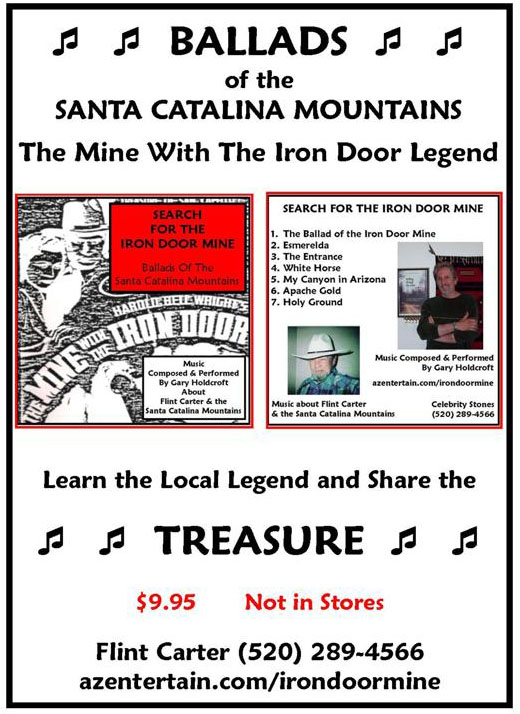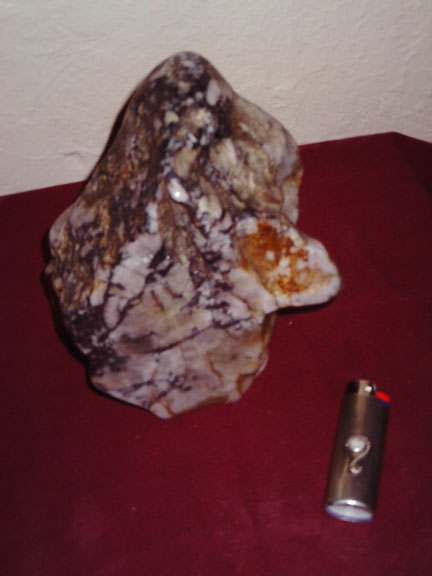|
Entertainment Magazine: Arizona: Saddlebrooke: History Saddlebrooke’s History That You Don’t KnowThe area where the Cañada del Oro River feeds out the west side of the Santa Catalina Mountains has been studied, explored and documented. The area is rich with history and legend. When the Motorola Executive Institute gave part of that area to the University of Arizona for the BioSphere, an archeological survey dated nearby carvings, between 4-6,000 years old, overlooked miles of pre-historic irrigation canals for farming. Ancient canals for farming had been found. The first documentation on the area - and of a particular mine - was in 1880 by an article in the Arizona Weekly Star. The story also mentions a lost city right in the mighty Cañada del Oro. Read more about the Iron Door Mine. By 1903, William “Buffalo Bill” Cody began mining in the area. He built roads near Oracle, hauled milling equipment, and believed to have found a rich deposit at a lost mine in Camp Bonito. At one time, 200 miners were employed to mine the backside of the Catalina Mountains. In 1911, below the BioSphere, George Stone Wilson started the Linda Vista Guest Ranch, formerly called Rancho Linda Vista. It was Arizona’s first guest ranch with two old adobe houses. One building is believed to be Mission Santa Catalina of Jesuit origin.
Marino Samaniego, born in 1844 in Sonora, Mexico, was a prominent Tucson pioneer. He arrived in Tucson in the mid-1860s and became a freighter, cattle rancher, merchant and a successful Hispanic public official during the territorial period in the 1890s. Samaniego was one of the founders and president of the Alianza Hispano-Americana, served on the first Board of Regents for the University of Arizona, and served as President, Vice President and Director for the Arizona Historical Society. He served four terms in the Territorial Assembly, on the County Board of Supervisors, on the Tucson City Council and as Pima County Assessor. In 1917, Wilson let Harold Bell Wright stay at the Coronado Camp, just over the Samaniego Ridge to the east of Saddlebrooke. This is where Wright had composed the book “The Mine with the Iron Door.”
The novel was made into one of Arizona’s first Western movies of the
same name. It was filmed at the local Linda Vista Ranch in 1924. The
subject was redone three more times for a total of four full-length
motion pictures. It was the only movie with multiple spin-offs on a
single topic until the Star Wars series. On a more noble note, it was not mentioned before that Motorola's ownership of the area originally belonged to the Countess of Suffolk, a concert pianist. It was called Casa del Oro, or House of Gold. The countess and Dr. Lachner, a dentist from Tucson, was first to build on top of the hill overlooking the now Saddlebrooke. He used the gold and silver from the area in his practice in Tucson. Also notable was that Ira Hays, of Iwo Jima fame, helped dig the countess' well, as told to me by Buster Bailey who hired him to do the job. Little did I know this was a key
geographical spot. It is the largest riparian area on Mt. Lemmon and it
was the main road from El Paso to San Diego before mechanization. William "Flint" Carter is available to speak to groups about the Old West, Southwestern legends, mining and other subjects. Almost of of his work, found throughout these pages, are available for sale. Call Flint n Tucson, Arizona at 520-289-4566 for more information. Visit William "Flint" Carter's web site. Saddlebrooke IndexTucson Entertainment MagazineArizona Entertainment Magazine Home Page© 2010-2011 EMOL.org Entertainment Magazine. All rights reserved. |
|
 The
property was acquired through back taxes from the Samaniego family-
whom the western ridge is named- Samaniego Ridge. The Samaniegos started
the Hispanic Rights Movement.
The
property was acquired through back taxes from the Samaniego family-
whom the western ridge is named- Samaniego Ridge. The Samaniegos started
the Hispanic Rights Movement. "Ballads of the Santa Catalina Mountains" CD
"Ballads of the Santa Catalina Mountains" CD

 (Left: Original art wortk by Flint Carter. 5" x 7" original, $500
(Left: Original art wortk by Flint Carter. 5" x 7" original, $500